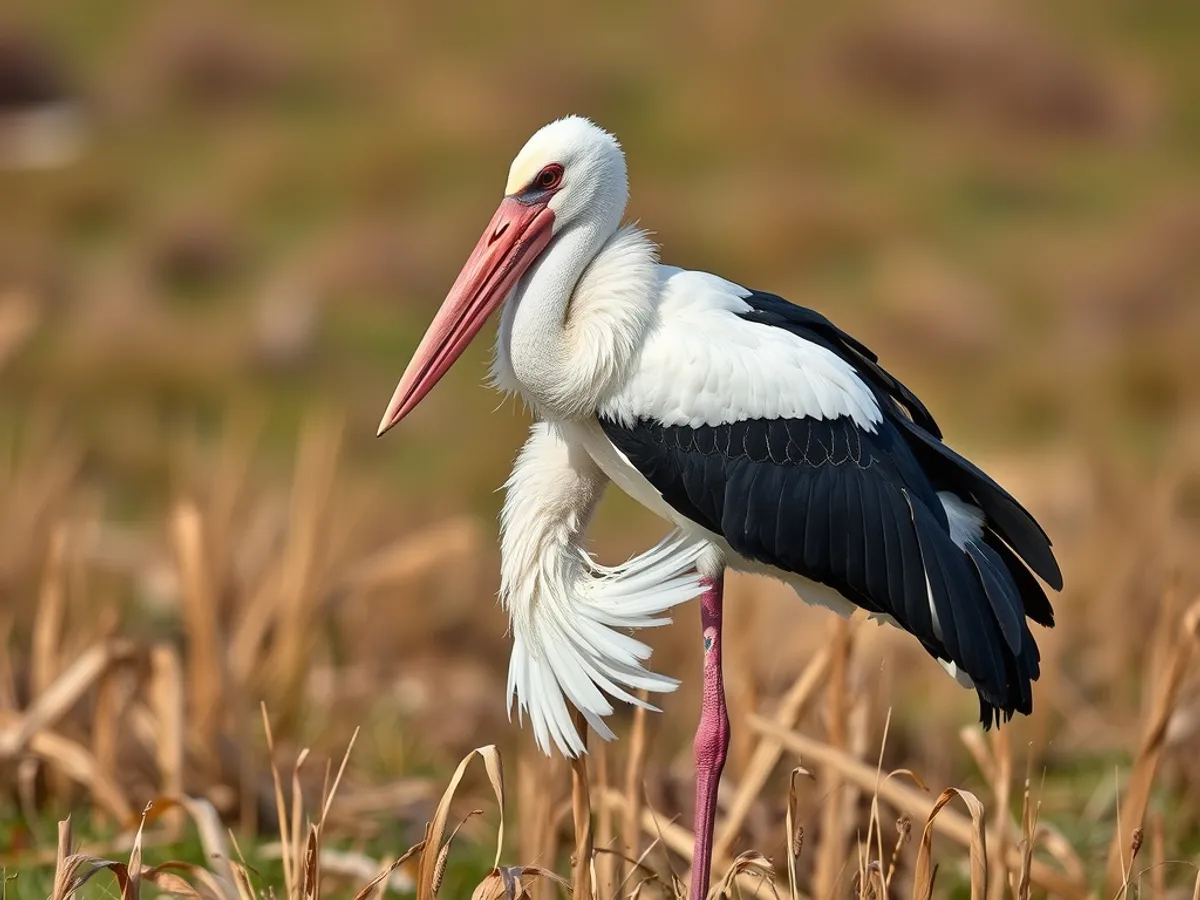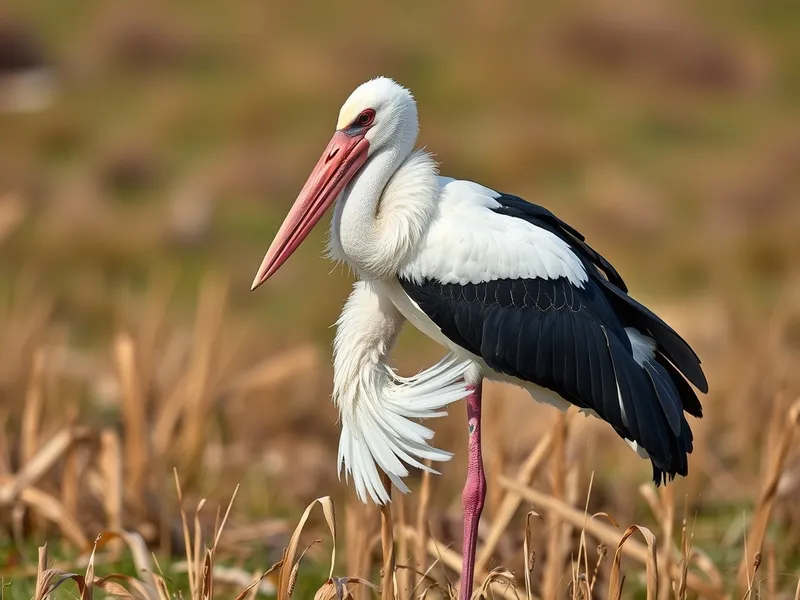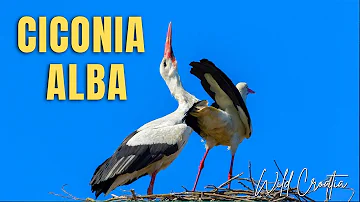
White Stork
Ciconia ciconia

Meet the White Stork
The White Stork is a large, long-legged wading bird known for its striking white plumage with contrasting black wing feathers and long, pointed red bill. Native to Europe, parts of North Africa, and western Asia, it is renowned for its graceful flight and distinctive migratory patterns. White Storks often nest on rooftops, tall trees, or purpose-built platforms, and their large stick nests are a common sight in rural villages. They are highly social during migration and breeding, often found in loose colonies and are famous for their association with folklore about delivering babies.
Classification
Bird
Habitat
Wetlands, grasslands, and farmlands
Diet
Carnivore
Lifespan
10-25 years
Conservation
Least Concern
Weight
2.3-4.5 kg
📖Fascinating Facts
Massive Nests
White Stork nests can be up to 2 meters in diameter and reused for decades by successive generations.
Epic Migrations
White Storks migrate more than 10,000 kilometers between Europe and sub-Saharan Africa each year.
Folklore Fame
They are deeply embedded in European folklore as the bearers of newborn babies.
📋Detailed Description
The White Stork (Ciconia ciconia) is a large, long-legged wading bird distinguished by its predominantly white plumage contrasted with black primary and secondary flight feathers. Adults typically measure 100–115 cm in length, with a wingspan ranging from 155 to 215 cm, and weigh between 2.3 and 4.5 kg. The species is characterized by its long, straight, pointed red bill and equally vivid red legs, adaptations for foraging in wetlands and open fields. White Storks exhibit sexual monomorphism, with males and females appearing similar, though males are slightly larger on average. Their eyes are dark brown, surrounded by a bare, blackish orbital ring. In flight, they display a distinctive silhouette with their necks outstretched and legs trailing behind, utilizing broad wings for soaring on thermals. Their vocalizations are limited, as adults lack a syrinx, but they communicate through bill-clattering, especially during courtship and territorial displays. White Storks are highly migratory, forming large flocks during seasonal movements between breeding grounds in Europe and wintering areas in sub-Saharan Africa or the Indian subcontinent. They are opportunistic feeders, preying on a wide range of small vertebrates and invertebrates. Nests are large, conspicuous stick platforms, often reused and expanded annually, and are commonly situated on rooftops, trees, or artificial structures. The species is notable for its adaptability to human-altered landscapes and its strong site fidelity, often returning to the same nest year after year.
💡 Did you know?
Unlike many birds, White Storks are mute and communicate mainly through bill-clattering rather than vocal calls.
🔬Research & Sources
Wikipedia Summary
The white stork is a large bird in the stork family, Ciconiidae. Its plumage is mainly white, with black on the bird's wings. Adults have long red legs and long pointed red beaks, and measure on average 100–115 cm (39–45 in) from beak tip to end of tail, with a 155–215 cm (61–85 in) wingspan. The two subspecies, which differ slightly in size, breed in Europe north to Finland, northwestern Africa, Palearctic east to southern Kazakhstan and southern Africa. The white stork is a long-distance migrant, wintering in Africa from tropical Sub-Saharan Africa to as far south as South Africa, or on the Indian subcontinent. When migrating between Europe and Africa, it avoids crossing the Mediterranean Sea and detours via the Levant in the east or the Strait of Gibraltar in the west, because the air thermals on which it depends for soaring do not form over water.
Last Modified: 6/2/2025
🎭Behavior & Social Structure
White Storks are diurnal and spend much of their day foraging in open habitats such as meadows, wetlands, and agricultural fields. They employ a slow, deliberate walking gait, using their keen eyesight to locate prey, which includes insects, amphibians, reptiles, small mammals, birds, and occasionally fish and earthworms. Foraging is typically solitary or in loose groups, but during migration and at communal roosts, they can gather in flocks numbering in the thousands. Social interactions are most pronounced during the breeding season, with complex courtship displays involving bill-clattering and mutual preening. They are territorial around nest sites but generally tolerant of conspecifics in foraging areas. White Storks are known for their strong migratory behavior, traveling up to 10,000 km between breeding and wintering grounds, often using established flyways that exploit rising air currents for energy-efficient soaring. Outside the breeding season, they exhibit communal roosting and may form temporary associations with other large wading birds.
👶Reproduction & Life Cycle
White Storks are monogamous within a breeding season, and many pairs reunite at the same nest site in successive years. The breeding season begins in March or April in Europe, with nest-building or refurbishment often preceding the arrival of the female. Nests are large, up to 2 meters in diameter and 1–2 meters deep, constructed from sticks and lined with softer materials. Females lay 3–5 eggs (range 2–7), which are incubated for 33–34 days by both parents. Chicks are altricial, hatching with sparse down and requiring extensive parental care. Both parents feed the young by regurgitation, and brooding continues intensively for the first two weeks. Fledging occurs at 58–64 days, but juveniles may remain near the nest and dependent on parents for several weeks post-fledging. Breeding success is influenced by food availability, weather conditions, and nest site quality.
🛡️Adaptations & Survival
White Storks possess several adaptations for their migratory and foraging lifestyle. Their long legs and toes allow efficient wading in shallow water and traversing uneven terrain, while the long, pointed bill is specialized for grasping and manipulating a variety of prey. Their large wings and low wing loading facilitate soaring flight, enabling them to exploit thermals and minimize energy expenditure during migration. Behavioral adaptations include strong site fidelity, communal roosting, and the ability to exploit anthropogenic habitats for nesting and foraging. Their limited vocal repertoire is compensated by distinctive bill-clattering, an important social and reproductive signal. Physiologically, they can tolerate a wide range of temperatures and are able to adjust their migratory timing and routes in response to environmental changes.
📚Research Sources
🎨Cultural Significance
The White Stork holds a prominent place in European folklore and mythology, often symbolizing good luck, fertility, and the arrival of spring. It is famously associated with the legend of delivering babies, a motif popularized in 19th-century literature and art. In many rural communities, stork nests are considered auspicious, and people often encourage nesting by providing platforms on rooftops or poles. The species is a national symbol in several countries, including Poland and Lithuania, and features in local festivals, stamps, and emblems. Its migratory journeys have inspired scientific study and cultural fascination for centuries.
🔬Recent Research & Discoveries
Recent research on White Storks has focused on migration ecology, utilizing GPS tracking to reveal detailed routes, stopover sites, and the influence of weather patterns on migratory timing. Studies have documented shifts in wintering behavior, with increasing numbers overwintering in southern Europe due to changes in food availability, particularly at landfill sites. Genetic analyses indicate low differentiation between populations, reflecting high gene flow across the species' range. Conservation research has evaluated the effectiveness of artificial nest platforms and the impact of environmental contaminants on reproductive success. Ongoing studies are examining the effects of climate change on breeding phenology and migratory behavior.
🎥Wildlife Videos

Storks - A Village Rooftop Saga - Go Wild
The white stork is the only large European bird that has attached itself to human beings. These elegant-looking birds build their ...
Go Wild

Flight of the Stork - Go Wild
This programme tells the story of a bird known and loved by everyone. In many cultures it is a bearer of good fortune. In ancient ...
Go Wild

The White Stork / Wild World
Nature And Wild Life - Birds are beautiful creature on our planet I will be sharing videos about animals. Please subscribe like and ...
solidsouth tv

Wild World - The White Stork | ZeeKay
Owing to its mythological reputation as the bringer of babies, the white stork is an extremely popular bird. The white stork has a ...
ZeeKay Family

The White Stork
The white stork is a majestic bird that graces the skies with its elegant presence. Renowned for its striking black-and-white ...
Wild Croatia

Black Storks: A Surprising Comeback in Germany | Free Documentary Nature
Black Storks: A Surprising Comeback in Germany | Free Wildlife Documentary Nature is a constant source of surprise, also of a ...
Free Documentary - Nature
🌍Habitat Information
The White Stork typically inhabits Wetlands, grasslands, and farmlands environments. White Storks have adapted to their environments with specialized features and behaviors.
Primary Habitat:
Wetlands, grasslands, and farmlands
More detailed habitat information will be available soon.
🛡️Conservation Status
The White Stork is currently classified as Least Concern. Conservation efforts are crucial for preserving this species for future generations.
Common Threats:
- 🏠Habitat loss and fragmentation
- 🌡️Climate change impacts
- 🎯Hunting and poaching
- 🏭Human-wildlife conflict
⚠️Threats & Conservation Challenges
While currently classified as Least Concern by the IUCN, White Storks face several threats. Habitat loss due to wetland drainage, agricultural intensification, and urbanization has historically reduced suitable foraging and nesting sites. Collisions with power lines, electrocution, and illegal hunting remain significant mortality factors, especially along migration routes. Pesticide use can reduce prey availability and cause direct poisoning. Climate change is altering migratory patterns and breeding phenology, with some populations now wintering in southern Europe rather than Africa. Conservation efforts, including nest platform installation, wetland restoration, and public awareness campaigns, have led to population recoveries in parts of Europe, but localized declines persist in some regions.
🔬Scientific Classification
Scientific Name
Ciconia ciconia
Classification Hierarchy
🔍 About Taxonomic Classification
Taxonomic classification is a hierarchical system used by scientists to classify and organize living organisms based on shared characteristics and evolutionary relationships.
The system moves from broad categories (Kingdom) to increasingly specific ones, with each animal's scientific name typically consisting of its Genus and species.
📝Community Notes
Share your observations and insights about the White Stork with our community of wildlife enthusiasts.
Join Our Community
Sign in to share your observations and connect with fellow wildlife enthusiasts.
Sign In to ContributeNo community notes yet
Be the first to share your observations about the White Stork!
Explore White Stork
Select a tab above to learn more about this amazing animal.
📸Photo Gallery
No photos available for this animal yet.
🌟Discover More Wildlife
Continue your journey of discovery with more fascinating animals from our database
